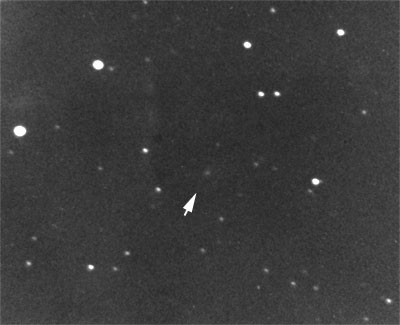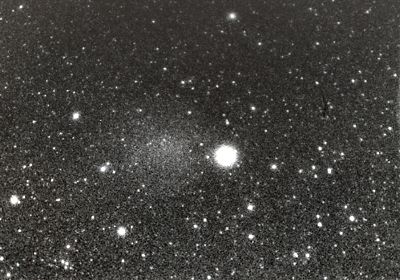February 11
Comet Kojima, the last observation with the 60cm reflector at Geisei
Mr. Shimomoto coined the word "last light" referring
to the last observation by a particular telescope, as opposed to first
light. "Last light" captured by Geisei's 60cm reflector was that
of periodic Comet Kojima (70P/Kojima).
I wonder how many thousands of photographs Geisei Observatory
have taken since it began to operate in 1981. The last of these countless
photographs is that of Comet Kojima presented here.
There are a number of interesting episodes about Comet Kojima
of 1971. I will soon reveal them in "The Stories of a Comet Hunter's
Life". It is perhaps not widely known that the discovery of Comet
Kojima became a trigger for the first Comet Conference. Three names (Tsutomu
Seki, Hisanobu Kojima, and Ichiro Hasegawa) are given in Yamamoto Circular
#1733 as the organizers of the first Comet Conference, which had been edited
and published by Mr. Ichiro Hasegawa.
The interesting thing is the association between Comet Kojima
and Neujmin 2 (25D/Neujmin 2). The latter has been long lost. Though these
two comets were determined to be separate comets, their orbits are so similar
that you would be tempted to believe that Neujmin 2 turned itself into
Comet Kojima.
Recently Mr. Kojima has sent me images taken by a 25cm-telescope
equipped with a CCD camera. It seems that his passion for comet discovery
has returned to him and begun pursuing his old dream.
On February 13, Goto Optical began working to dismantle and
remove Geisei's 60cm reflector, which they had built. Beautiful stars will
continue to shine over the empty observatory dome. The radio program "Midnight
Letter" was produced by NHK, in which I reminisced about the 60cm
reflector. It will be broadcast again on March 10.

70P/Kojima (periodic Comet Kojima)
20-minute exposure from 1:41, February 11, 2008 (J.S.T)
60cm f/3.5 reflector, Fuji Acros 100 film
This is the last photograph of the 60cm reflector.
Tenacious Comet Holmes
17P/Holmes is quite a tenacious comet. From Geisei Observatory
it is still easily visible. The coma is large and fluffy like cotton candy.
On February 8 it took up a third of the 10x70 binoculars' 5.1-degree field,
which means it is as large as 1.7 degrees in diameter. However, the diffused
coma was invisible in the 20cm refractor at 40x and it seems the naked
eye or binoculars to be more suitable for seeing it.
It is very difficult to estimate the total magnitude of the
comet when it takes on this sort of appearance. M33 in Triangulum, for
example, is listed as a 7th-magnitude galaxy. Though it looked very faint
through the 188cm reflector at Okayama Astrophysics Observatory, which
I visited about 30 years ago, it was faintly visible to the naked eye at
Geisei Observatory. It is hard to believe but true. Comet Holmes has an
unusually diffused coma. If all the glow in the coma were concentrated
at a point, it would be surprisingly brighter. This is a peculiarity of
the total magnitude.
While looking at this tenuous Comet Holmes, I remembered
an episode about Earth's second satellite. About 40 years ago, a certain
astronomer made a claim that a dynamical effect collected space dust at
a position 90 degrees away from the Moon and formed a tenuous second moon.
He even traveled to a very dark site in the Tetra Mountains of Czechoslovakia
(present Slovakia) and reportedly confirmed it with a 35mm camera. When
this story became known widely, Mr. Ike, who had an inquisitive mind about
curious incidents, climbed Ishizuchiyama mountain (elevation 1982 meters)
on one freezing wintry day and attempted to photograph this "moon"
with a 35mm camera equipped with a short focal lens. Shortly after the
discovery of Comet Ikeya-Seki, Mr. Ike traveled far and wide looking for
a chance to witness Ikeya-Seki, even risking his life at times. He lived
up to his reputation as an "astronomy adventurer Ike".
Staring at faint and diffused Comet Holmes, I wondered if
the "second moon" resembled this tenuous appearance of Comet
Holmes. My thought drifted over to the fond memories of those old days.

17P/Holmes
The bright star at the center is Beta Persei. The faint diffused glow to the left is Comet Holmes.
10-minute exposure from 22.00, January 25, 2008 (J.S.T.)
Nikon FM 135mm f/2.0, Fuji 1600 film


